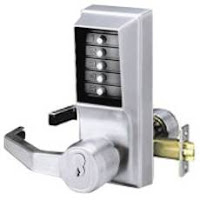 |
| Example of Master Key Chart |
1. Promptly changes the locks at a business.
2. Gets paid.
3. Stops showing up promptly for the little jobs.
4. Is asked by the customer to turn over the keying information and refuses.
5. Doesn't care because he knows the customer is now at his mercy.
Why should you require the lock keying information before the job is started? Because, if you don't, you will never get it. Without the keying information, you will not be able to expand your master key system. Why? Because, without it, the next locksmith may create a key that will inadvertently unlock a lock it is not supposed to unlock. If this happens, everyone can get sued.
Now, you know the truth and, hopefully, you know to ask for the key bitting charts before the locksmith begins your job. Oh, by the way - your locksmith will say, "The lock chart is intellectual property." Hogwash. The guy has a computer program that does it for him.
What does the bitting chart and codes sheet have on it?
1. Key numbers. In our illustration, the key numbers are 1AA, 2AA, etc.
2. The key cutting information (adjacent to the key number. 6AA - 546767).
3. The bottom and master pin numbers, pins used in the key cylinders.
Without this information in your possession, the locksmith who did the original work can give you shoddy service and raise his prices.
How do you get around not having the master key charts and bitting lists? A good locksmith can take a pair of calipers and measure every cut in every key you have and determine the system. That, however, takes time and money.
The moral of the story? If you are an office manager or a maintenance supervisor, you must ask for and receive from your locksmith, in writing, before the job begins, that he will turn over to you all of the keying information. If he refuses, call HL Flake in Memphis, Tennessee, and ask them to design a key system for you. Then, look for another locksmith.






